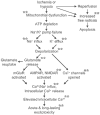Protecting motor networks during perinatal ischemia: the case for delta-opioid receptors
- PMID: 20536941
- PMCID: PMC3157952
- DOI: 10.1111/j.1749-6632.2010.05434.x
Protecting motor networks during perinatal ischemia: the case for delta-opioid receptors
Abstract
Perinatal ischemia is a common clinical problem with few successful therapies to prevent neuronal damage. Delta opioid receptor (DOR) activation is a versatile, evolutionarily conserved, endogenous neuroprotective mechanism that blocks several steps in the deleterious cascade of neurological events during ischemia. DOR activation prior to ischemia or severe hypoxia is neuroprotective in spinal motor networks, as well as cortical, cerebellar, and hippocampal neural networks. In addition to providing acute and long-lasting neuroprotection against ischemia, DOR activation appears to provide neuroprotection when given before, during, or following the onset of ischemia. Finally, DORs can be upregulated by several physiological and experimental perturbations. Potential adverse side effects affecting motor control, such as respiratory depression and seizures, are not well established in young mammals and may be mitigated by altering drug choice and method of drug administration. The unique features of DOR-dependent neuroprotection make it an attractive potential therapy that may be given to at-risk pregnant mothers shortly before delivery to provide long-lasting neuroprotection against unpredictable perinatal ischemic events.
Figures

Similar articles
-
Neuroprotection against hypoxia/ischemia: δ-opioid receptor-mediated cellular/molecular events.Cell Mol Life Sci. 2013 Jul;70(13):2291-303. doi: 10.1007/s00018-012-1167-2. Epub 2012 Sep 27. Cell Mol Life Sci. 2013. PMID: 23014992 Free PMC article. Review.
-
Delta opioid receptors in brain function and diseases.Pharmacol Ther. 2013 Oct;140(1):112-20. doi: 10.1016/j.pharmthera.2013.06.003. Epub 2013 Jun 10. Pharmacol Ther. 2013. PMID: 23764370 Free PMC article. Review.
-
Hypoxic preconditioning attenuates global cerebral ischemic injury following asphyxial cardiac arrest through regulation of delta opioid receptor system.Neuroscience. 2012 Jan 27;202:352-62. doi: 10.1016/j.neuroscience.2011.11.060. Epub 2011 Dec 21. Neuroscience. 2012. PMID: 22200548
-
Non-analgesic effects of opioids: neuroprotection in the retina.Curr Pharm Des. 2012;18(37):6101-8. doi: 10.2174/138161212803582441. Curr Pharm Des. 2012. PMID: 22747547 Review.
-
Delta-opioid receptor activation prolongs respiratory motor output during oxygen-glucose deprivation in neonatal rat spinal cord in vitro.Neuroscience. 2011 Jul 28;187:70-83. doi: 10.1016/j.neuroscience.2011.04.059. Epub 2011 May 6. Neuroscience. 2011. PMID: 21571044 Free PMC article.
Cited by
-
A novel mechanism for cytoprotection against hypoxic injury: δ-opioid receptor-mediated increase in Nrf2 translocation.Br J Pharmacol. 2015 Apr;172(7):1869-81. doi: 10.1111/bph.13031. Epub 2015 Feb 10. Br J Pharmacol. 2015. PMID: 25439010 Free PMC article.
-
Delta Opioids: Neuroprotective Roles in Preclinical Studies.J Ocul Pharmacol Ther. 2018 Jan/Feb;34(1-2):119-128. doi: 10.1089/jop.2017.0039. J Ocul Pharmacol Ther. 2018. PMID: 29451852 Free PMC article. Review.
-
Neuroprotection against hypoxia/ischemia: δ-opioid receptor-mediated cellular/molecular events.Cell Mol Life Sci. 2013 Jul;70(13):2291-303. doi: 10.1007/s00018-012-1167-2. Epub 2012 Sep 27. Cell Mol Life Sci. 2013. PMID: 23014992 Free PMC article. Review.
-
Delta opioid receptor analgesia: recent contributions from pharmacology and molecular approaches.Behav Pharmacol. 2011 Sep;22(5-6):405-14. doi: 10.1097/FBP.0b013e32834a1f2c. Behav Pharmacol. 2011. PMID: 21836459 Free PMC article. Review.
-
Delta opioid receptors in brain function and diseases.Pharmacol Ther. 2013 Oct;140(1):112-20. doi: 10.1016/j.pharmthera.2013.06.003. Epub 2013 Jun 10. Pharmacol Ther. 2013. PMID: 23764370 Free PMC article. Review.
References
-
- Raju TN, Nelson KB, Ferriero D, et al. NICHD-NINDS Perinatal stroke workshop participants: Ischemic perinatal stroke: summary of a workshop sponsored by the National Institute of Neurological Disorders and Stroke. Pediatrics. 2007;120:609–616. - PubMed
-
- Nelson KB. Perinatal Ischemic Stroke. Stroke. 2007;38:742–745. - PubMed
-
- Rennie JM, Hagmann CF, Robertson NJ. Outcome after intrapartum hypoxic-ischemia at term. Semin in Fetal & Neonatal Med. 2007;12:398–407. - PubMed
-
- Badr LK, Purdy I. Brain injury in the infant: The old, the new and the uncertain. J Perinat Neonat Nurs. 2006;20:163–175. - PubMed
-
- Volpe JJ. Brain injury in the premature infant--current concepts. Prev Med. 1994;23:638–645. - PubMed

